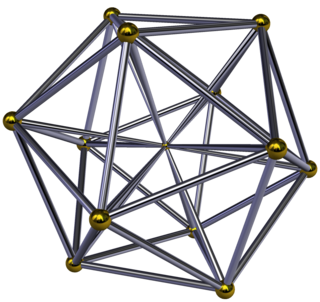Icosahedral pyramid
| Icosahedral pyramid | ||
|---|---|---|
 Schlegel diagram | ||
| Type | Polyhedral pyramid | |
| Schläfli symbol | ( ) ∨ {3,5} | |
| Cells | 21 | 1 {3,5} 20 ( ) ∨ {3} |
| Faces | 50 | 20+30 {3} |
| Edges | 12+30 | |
| Vertices | 13 | |
| Dual | Dodecahedral pyramid | |
| Symmetry group | H3, [5,3,1], order 120 | |
| Properties | convex, regular-faces | |
The icosahedral pyramid is a four-dimensional convex polytope, bounded by one icosahedron as its base and by 20 triangular pyramid cells which meet at its apex. Since an icosahedron's circumradius is less than its edge length,[1] the tetrahedral pyramids can be made with regular faces.
The regular 600-cell has icosahedral pyramids around every vertex.
The dual to the icosahedral pyramid is the dodecahedral pyramid, seen as a dodecahedral base, and 12 regular pentagonal pyramids meeting at an apex.
References
- ^ Klitzing, Richard. "3D convex uniform polyhedra x3o5o - ike"., circumradius sqrt[(5+sqrt(5))/8 = 0.951057
External links
- Olshevsky, George. "Pyramid". Glossary for Hyperspace. Archived from the original on 4 February 2007.
Wikimedia Commons has media related to Pyramids (geometry).
- Klitzing, Richard. "4D Segmentotopes".
- Klitzing, Richard. "Segmentotope ikepy, K-4.84".
- Richard Klitzing, Axial-Symmetrical Edge Facetings of Uniform Polyhedra

